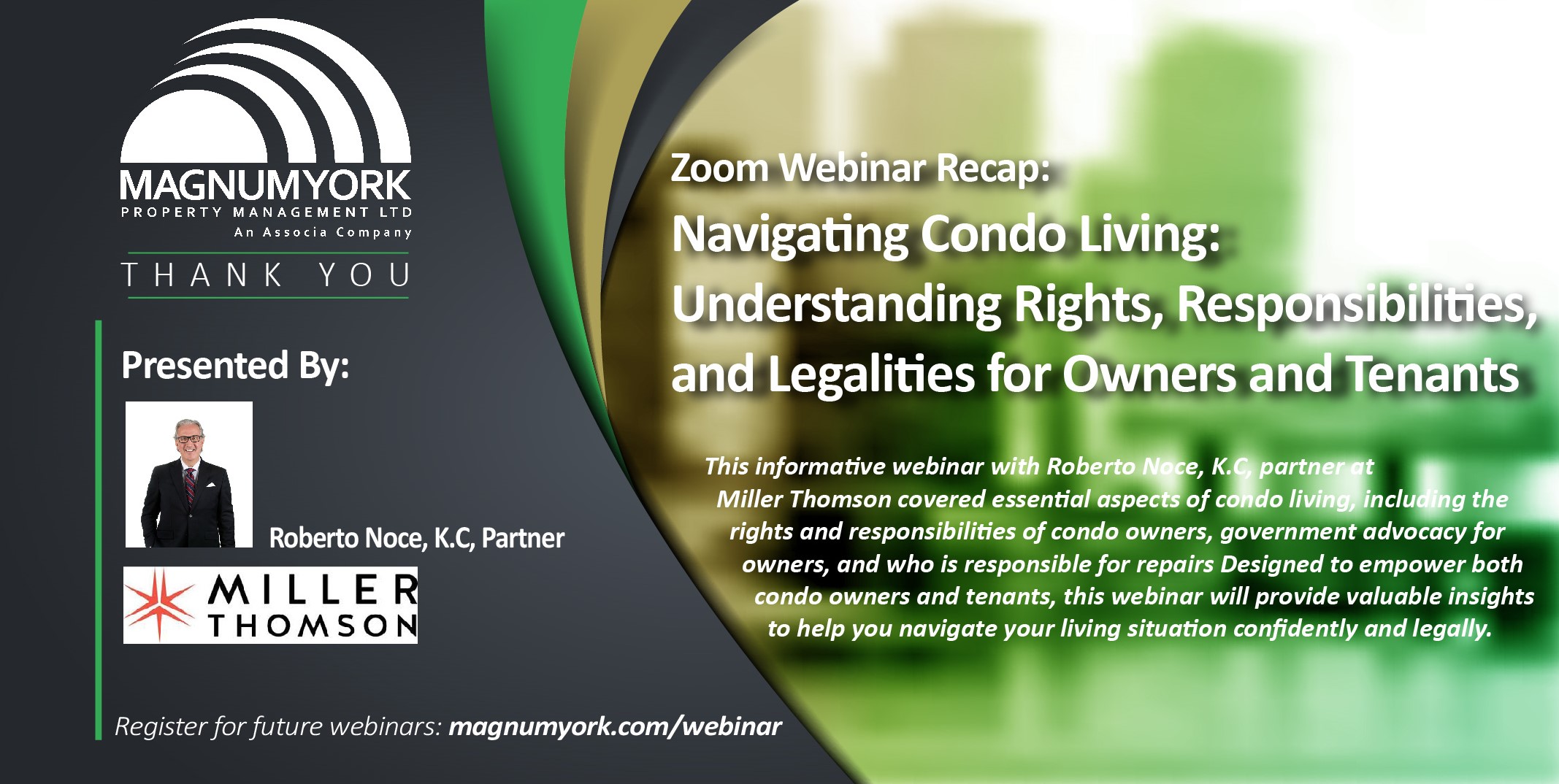Share this post

We recently hosted a webinar featuring Roberto Noce, KC, a leading Alberta condominium lawyer and partner at Miller Thomson LLP. This session was packed with practical legal insights for condo owners, tenants, and board members.
Roberto Noce is an experienced Alberta lawyer focusing on condominium law, real estate development, municipal law, and corporate/commercial matters. His clients include municipalities, developers, and condominium corporations, and he regularly represents them before various legal bodies. Roberto is widely recognized as one of Alberta’s leading authorities on condominium law.
Roberto is a member of the Law Society of Alberta and the Canadian Bar Association. He has been consistently recognized as one of The Best Lawyers in Canada for his experience in Municipal Law. Among his accolades are the Queen Elizabeth II Diamond Jubilee Medal, and in 2007, he was appointed King’s Counsel (formerly Queen’s Counsel), highlighting his exceptional legal acumen.
Table of Contents
The Legal Foundation of Condo Living
Roberto began by walking through the core documents that govern condominium living in Alberta, specifically:
- Condominium Plan: A Condominium Plan is a very important document that outlines the boundaries of individual units, the common property shared by all owners, and the unit factors assigned to each unit. The plan is identified by a 7-digit number, which carries specific meaning:
- First two digits: Indicate the year the plan was registered.
- Third digit: Represents the location or office where the registration took place.
- CADS (Condominium Additional Document Sheet): The CADS is a key document that provides essential details about the condominium. It includes:
- The total number of units in the building
- A list of current board members
- The designated address for service
- Insurance information for the property
- Bylaws: Establish the rules governing the condo’s operation, including the board’s structure, pet policies, and smoking restrictions.
- Standard Insurable Unit Description (SIUD): Clarifies what the corporation insures vs. what the owner is responsible for repairing or replacing.
He emphasized that these documents are legally binding and can be accessed through Land Titles.
Owners vs. Tenants: Who’s Responsible?
A major theme of the webinar was the shared responsibility between owners and tenants:
- Tenants must follow the bylaws, even if they haven’t read them.
- Owners are ultimately liable for their tenants’ actions, including fines and legal costs.
- Boards cannot ignore bylaw breaches, even if the violator is well-liked.
- Owners must notify the board of tenant names and rent amounts, as required by the Condominium Property Act.
Maintenance & Repairs: Who Pays for What?
One of the most common and often confusing topics in condo living is understanding who is responsible for what when it comes to repairs and maintenance. Roberto provided a clear breakdown of how responsibilities are divided between the condominium corporation and individual unit owners, and why it’s so important to refer to your governing documents.
Condominium Corporation Responsibilities
The corporation is legally responsible for maintaining and repairing:
- Common property: This includes areas shared by all owners, such as hallways, elevators, lobbies, roofs, exterior walls, parking lots, and landscaping.
- Managed property: In some cases, this includes areas that are technically part of a unit but are maintained by the corporation (e.g., balconies, patios, or exterior doors).
- Real and personal property owned by the corporation: This could include shared equipment, amenities, or mechanical systems.
These responsibilities are outlined in the Condominium Property Act and are typically funded through condo fees and reserve funds.
Owner Responsibilities
Owners are generally responsible for:
- Everything inside their unit, including walls, flooring, cabinetry, appliances, and plumbing fixtures—unless otherwise specified in the governing documents.
- Upgrades or improvements made to the unit. For example, if the standard finish is Arborite countertops and an owner installs marble, the corporation is only obligated to restore the unit to the standard finish in the event of damage.
Roberto emphasized that the Standard Insurable Unit Description (SIUD) is a critical document. It defines what the corporation’s insurance will cover in the event of damage and what falls under the owner’s responsibility. If you’ve made upgrades beyond the standard, it’s your responsibility to insure those improvements.
Reserve Fund Studies: Planning for the Future
To ensure the corporation can meet its repair obligations, Alberta law requires a reserve fund study every five years. This study:
- Assesses the condition of major building components (e.g., roof, windows, elevators).
- Projects when repairs or replacements will be needed.
- Recommends how much money should be set aside to cover those costs.
Roberto noted that boards must take these studies seriously and budget accordingly. Failing to do so can result in special levies and unexpected charges to owners to cover urgent repairs.
When Disputes Arise
While most responsibilities are clearly defined, disputes can still occur, especially when it’s unclear whether something is part of the unit or common property. In those cases:
- The condominium plan is the first place to look. It defines unit boundaries and common property.
- If the plan doesn’t resolve the issue, the bylaws and SIUD are consulted.
- If there’s still uncertainty, legal counsel may be needed to interpret the documents and advise the board.
Bylaws: When and Why to Update
Many boards operate with outdated bylaws. Roberto recommends reviewing them every 5 years, even if no changes are made. He shared examples of bylaws still referencing obsolete technologies like Telex, and warned that outdated bylaws may conflict with current human rights legislation.
Q&A
Q1: What can a condo board do about a non-resident owner who hasn’t paid condo fees for over 6 months?
A: The board should send demand letters. If unpaid, the file can go to a lawyer who may involve the lender or begin foreclosure to recover the debt.
Q2: Can a condo board evict or fine families who now have children in an adult-only building?
A: Yes, if the bylaws clearly state it’s an adult-only building. However, the wording must be specific, and exceptions (like temporary stays) may apply.
Q3: Our bylaws are over 15 years old. When should we update them?
A: Review bylaws every 5 years. Even if no changes are needed, ensure they’re up to date with current laws and don’t contain outdated terms or conflict with human rights legislation.
Q4: What’s the difference between cosmetic and non-cosmetic renovations?
A: Minor repairs like replacing cabinet doors are cosmetic and usually don’t need board approval. Full kitchen renovations likely do. When in doubt, ask your property manager.
Q5: Can the board require all water lines (e.g., to fridges, dishwashers) to be replaced with stainless steel?
A: Yes, if it’s part of a maintenance strategy for common property. The board can implement such policies to prevent damage.
Q6: Can the board require shut-off valves on toilets to prevent flooding?
A: Possibly, but it depends on whether the plumbing is part of common property. If not, the board may choose to cover the cost for the greater good.
Q7: Can reserve fund money be invested in mutual funds or ETFs?
A: This is a complex legal issue. The Condominium Property Act has rules about how reserve funds can be invested. Boards should consult legal counsel before making such decisions.
Q8: What can owners do if a developer tries to “deregister” or terminate the condo status?
A: Terminating a condo is legal in Alberta and sometimes makes economic sense, especially for older buildings. Owners should assess the financial impact and consult legal advice.
Q9: Are scent-generating devices (like diffusers) allowed on balconies?
A: Check your bylaws. Most won’t specifically mention diffusers, so legal interpretation may be needed. Some bylaws restrict smoking or strong scents.
Q10: Can a management company charge an admin fee on a chargeback to a unit?
A: Yes, if it’s reasonable and related to actual work (e.g., filing a caveat). Excessive fees may not be enforceable.
Q11: Can the board install a secure mailbox for packages in the lobby?
A: Yes. Boards can make improvements that enhance safety and convenience for residents, as long as costs are reasonable.
Q12: Can the board create a flooring policy to reduce noise in older buildings?
A: Possibly, but noise issues are complex. Boards should proceed carefully and may need legal advice to ensure enforceability.
Q13: Are plumbing lines in a bathroom considered common property or the owner’s responsibility?
A: It depends on your condo plan and bylaws. Each building is different, so you must check your documents to determine responsibility.
Conclusion
We hope this session empowered you with the tools and clarity needed to make informed decisions in your condo community. We want to thank Roberto for providing clear, actionable insights that help demystify the complexities of condo governance.
Thank you to everyone who attended and submitted thoughtful questions. Your engagement is what makes these sessions so valuable.
Don’t Miss Our Next Webinar
Join us on November 18 for our upcoming session with DKI Calgary, where we’ll revisit the important topic of hoarding in condo communities. Register here: https://magnumyork.com/webinar/
Further Resources:
- Miller Thomson LLP
- Webinar Recap: Understanding Bylaws and Navigating Tenant and Owner Challenges with SVR Lawyers
- Webinar Recap – Ensuring Financial Transparency and Compliance for Condominium Owners: A Comprehensive Guide with Murray Hunter Professional Corporation
- Register for future webinars: https://magnumyork.com/webinar/
Follow us on social media to stay up to date with industry news!

